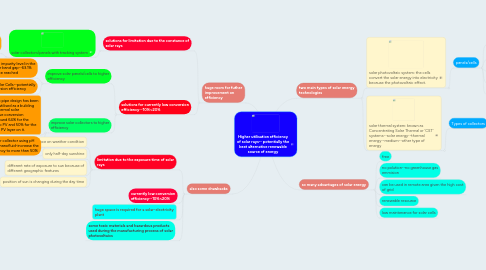
1. also some drawbacks
1.1. limitation due to the exposure time of solar rays
1.1.1. high dependance on weather condition
1.1.2. only half-day sunshine
1.1.3. different rate of exposure to sun because of different geographic features
1.1.4. position of sun is changing during the day time
1.2. currently low conversion efficiency--10%~20%
1.3. huge space is required for a solar-electricity plant
1.4. some toxic materials and hazardous products used during the manufacturing process of solar photovoltaics
2. huge room for futher improvement on efficiency
2.1. solutions for limitation due to the constance of solar rays
2.1.1. solar collectors/panels with tracking system
2.1.1.1. as result, the full surface area of all collectors/panels can be directed to the solar rays all the time
2.1.1.1.1. Dousoky, G.M., El-Sayed, A.H.M. and Shoyama, M., 2012, September. Increasing energy-efficiency in solar radiation trackers for photovoltaic arrays. In Energy Conversion Congress and Exposition (ECCE), 2012 IEEE (pp. 4113-4120). IEEE.
2.2. solutions for currently low conversion efficiency--10%~20%
2.2.1. improve solar panels/cells to higher efficiency
2.2.1.1. introducing an impurity level in the semiconductor band gap--63.1% efficiency limite reached
2.2.1.1.1. Luque, A. and Martí, A., 1997. Increasing the efficiency of ideal solar cells by photon induced transitions at intermediate levels. Physical Review Letters, 78(26), p.5014.
2.2.1.2. III-V Multi-Junction Solar Cells--potentially reach over 40% conversion efficiency
2.2.1.2.1. Yamaguchi, M., Takamoto, T., Araki, K. and Ekins-Daukes, N., 2005. Multi-junction III–V solar cells: current status and future potential. Solar Energy, 79(1), pp.78-85.
2.2.2. improve solar collectors to higher efficiency
2.2.2.1. A novel flat heat pipe design has been developed and utilised as a building envelope and thermal solar collector-improve conversion efficiency of around 64% for the collector with no PV and 50% for the system with the PV layer on it.
2.2.2.1.1. Jouhara, H., Milko, J., Danielewicz, J., Sayegh, M.A., Szulgowska-Zgrzywa, M., Ramos, J.B. and Lester, S.P., 2015. The performance of a novel flat heat pipe based thermal and PV/T (photovoltaic and thermal systems) solar collector that can be used asan energy-active building envelope material.
2.2.2.2. a flat plate solar collector using pH treated Al2O3 nanofluid-increase the thermal efficiency to more than 50%
2.2.2.2.1. Said, Z., Saidur, R., Sabiha, M.A., Hepbasli, A. and Rahim, N.A., 2016. Energy and exergy efficiency of a flat plate solar collector using pH treated Al 2 O 3 nanofluid. Journal of Cleaner Production, 112, pp.3915-3926.
3. so many advantages of solar energy
3.1. free
3.2. no polution--no greenhouse gas emmision
3.3. can be used in remote area given the high cost of grid
3.4. renewable resource
3.5. low maintenance for solar cells
4. two main types of solar energy technologies
4.1. solar photovoltaic system: the cells convert the solar energy into electricity because the photovoltaic effect.
4.1.1. panels/cells
4.1.1.1. Crystalline Silicon (c-Si)
4.1.1.1.1. Us, A. and Maehlum, M. (2012). Which Solar Panel Type is Best? Mono-, Polycrystalline or Thin Film?. [online] Energy Informative. Available at: http://energyinformative.org/best-solar-panel-monocrystalline-polycrystalline-thin-film/ [Accessed 10 Apr. 2016].
4.1.1.2. Monocrystalline Silicon Solar Cells
4.1.1.3. Polycrystalline Silicon Solar Cells
4.1.1.4. String Ribbon Solar Cells
4.1.1.5. Thin-Film Solar Cells (TFSC)
4.2. solar thermal system: known as Concentrating Solar Thermal or ‘CST’ systems--solar energy--thermal energy--medium--other type of energy
4.2.1. Types of collectors
4.2.1.1. Flat plate collectors
4.2.1.2. Evacuated tube collectors

